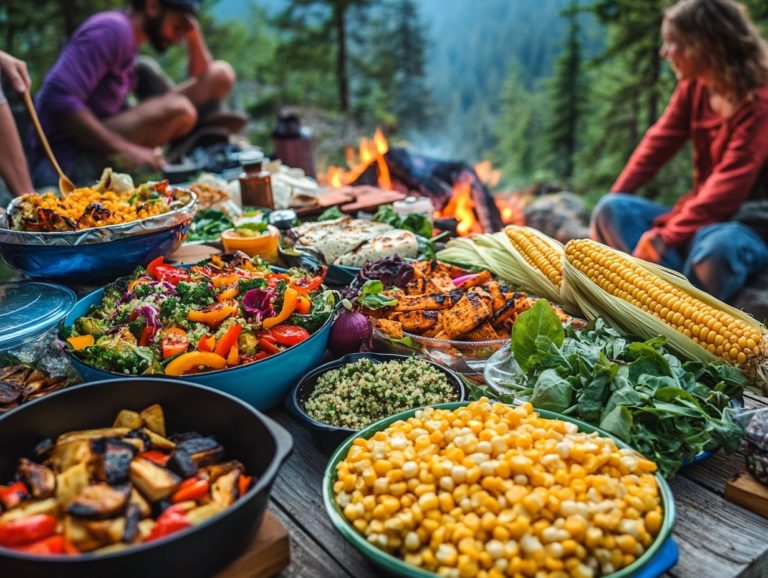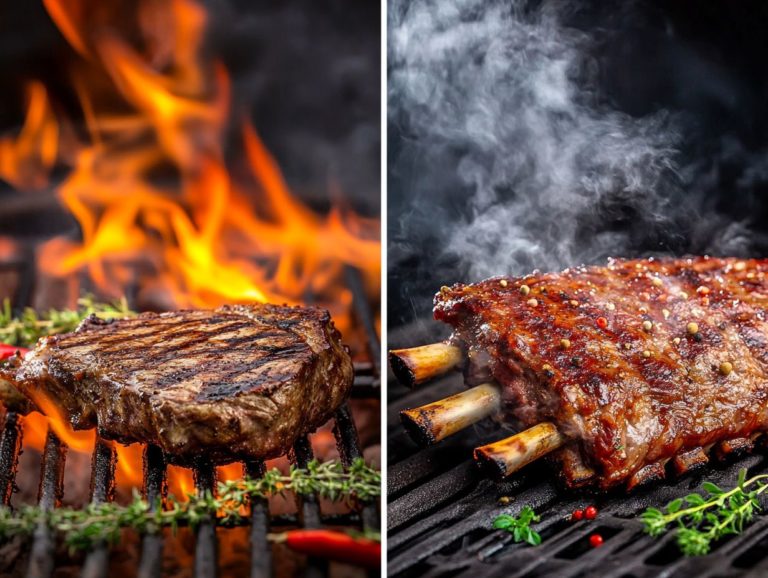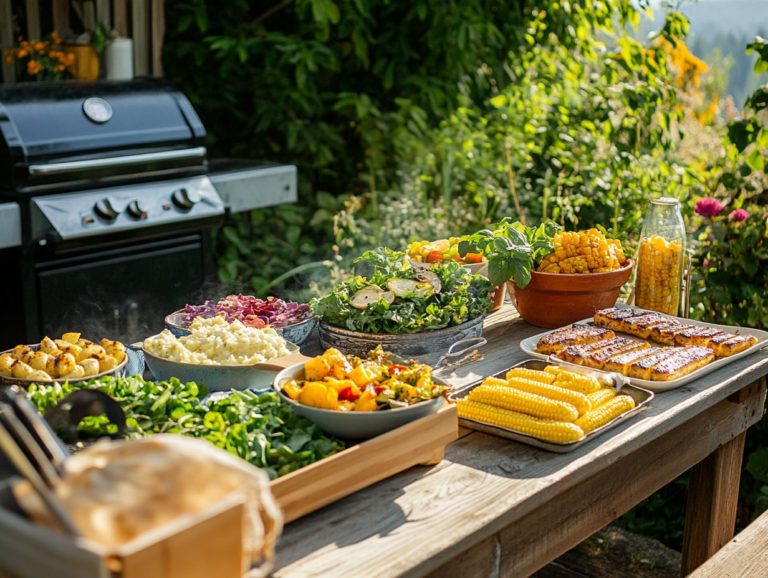How Long Can Food Sit Outside?
Food safety is vital for safeguarding your health and well-being. Grasping how food can spoil and the measures to prevent it, including proper care, is essential knowledge for everyone.
This article delves into the significance of food safety, the factors that lead to spoilage, and provides guidelines on how long various types of food, including perishable foods, can safely sit outside.
You’ll learn to identify the signs of spoiled food and uncover practical tips for food storage and handling.
By mastering these essential food safety practices, including refrigeration tips, you can ensure that your meals remain both safe and delicious!
Contents
- Key Takeaways:
- Understanding Food Safety
- Factors Affecting Food Spoilage
- How Long Can Food Sit Outside?
- Signs of Spoiled Food
- Preventing Food Spoilage
- Frequently Asked Questions
- How long can food sit outside without spoiling?
- What happens if food sits outside for too long?
- Can I leave food outside for a picnic or BBQ?
- How long can fruits and vegetables sit outside?
- Is it safe to eat food that has been left outside in cold weather?
- What should I do if I am unsure about the safety of food that has been left outside?
Key Takeaways:

- Proper food safety is crucial to prevent foodborne illnesses.
- The length of time food can sit outside depends on temperature, time, and bacterial growth.
- Follow guidelines for different types of food to prevent spoilage, and regularly check for signs of spoilage to avoid consuming contaminated food.
Understanding Food Safety
Understanding food safety is crucial for protecting you and your family. It includes practices that prevent foodborne illnesses caused by germs like Salmonella, E. coli, and Staphylococcus aureus.
Food safety experts stress the importance of effective food management. This encompasses safe handling techniques, awareness of the temperature danger zone, and proper storage of leftovers. By adhering to these guidelines, you can significantly lower the risks of food poisoning and make informed decisions about your nutrition and food consumption.
Why is Food Safety Important?
Food safety is your shield against illness. It protects you and your loved ones from foodborne illnesses, which can lead to serious health complications or, in the worst cases, even death.
Without rigorous food safety practices, harmful germs like Salmonella and E. coli can flourish, resulting in outbreaks that threaten countless individuals. Each year, around 48 million Americans experience the consequences of foodborne illnesses, leading to approximately 128,000 hospitalizations and 3,000 fatalities. These staggering numbers highlight the urgent need for constant vigilance.
The economic impact is equally alarming, with foodborne illnesses costing the U.S. economy about $15.6 billion each year in medical expenses and lost productivity. Follow health nutrition guidelines now to protect yourself and your family from serious risks!
Factors Affecting Food Spoilage
Several factors contribute to food spoilage, impacting the quality and safety of what you consume. Understanding these factors is essential for effective food management and for preventing foodborne illnesses linked to spoiled items.
Temperature plays a critical role, especially within the temperature danger zone, where bacteria growth can occur at an alarming rate. By grasping how various perishable foods react to different conditions, you can minimize waste and uphold food safety in your kitchen.
Temperature, Time, and Bacterial Growth

The relationship between temperature, time, and bacterial growth is crucial for ensuring your food safety, especially when it comes to storing cooked dishes and leftovers.
Keeping food in the temperature danger zone between 40 F and 140 F invites bacteria to grow quickly. This range is a breeding ground for germs that spoil your food and can cause illness.
For example, if you leave food out for more than two hours at room temperature, it becomes unsafe. And if those temperatures creep up even higher, the risk escalates, exposing your food to heightened microbial activity.
To mitigate these risks, employing proper food storage techniques is essential. Promptly refrigerating food, especially leftovers below 40 F and reheating them to at least 165 F, can significantly diminish the danger. Freezing is another effective strategy, effectively halting bacterial growth and ensuring your food quality remains intact.
How Long Can Food Sit Outside?
Understanding how long food can safely remain outside is essential to safeguard against foodborne illnesses, especially during gatherings or outdoor events like picnics or BBQs. Being aware of these guidelines not only protects your guests but also enhances the overall enjoyment of the occasion.
General Guidelines for Different Types of Food
Different types of food have their own time limits for safe consumption, including condiments. Therefore, it is essential to follow specific food safety guidelines.
By knowing these limits, you can prevent foodborne illnesses and ensure that your meals remain safe and enjoyable. As a rule of thumb, cooked dishes shouldn’t sit out for more than two hours. If the temperature climbs above 90 F, that window shrinks to just one hour. Condiments have a bit more leeway due to their preservatives, but it’s still wise to use them within a few hours. Foods that spoil easily, such as dairy and meat, demand strict attention you should never leave them out for more than one hour in warm weather.
Improve your food safety with proper refrigeration techniques. For items like cheese and cooked dishes, maintaining a consistent temperature below 40 F and organizing your items to promote airflow can significantly extend their lifespan.
Signs of Spoiled Food
Recognizing the signs of spoiled food is crucial for avoiding food poisoning and ensuring a safe dining experience. By staying vigilant, you can protect yourself and your loved ones from potential health risks associated with consuming spoiled items.
Identifying and Discarding Spoiled Food

Identifying and discarding spoiled food is crucial for effective food management and maintaining safety in your kitchen. It s not just about keeping things tidy; it s about protecting your health. Spoiled foods can harbor harmful bacteria, including Salmonella and E. coli, that multiply rapidly in the right conditions.
Checking for off smells, changes in color, or unusual textures is essential in determining whether those foods that spoil easily are still fit for consumption. By adhering to food safety guidelines, such as proper storage and disposal practices, you significantly reduce the risk of foodborne illnesses.
Keep in mind that consuming spoiled food can lead to serious health issues, including nausea, diarrhea, and, in severe cases, hospitalization. By being proactive in recognizing spoilage and understanding its implications, you can safeguard your overall well-being.
Preventing Food Spoilage
You can keep your food fresh and safe by preventing spoilage! Taking proactive measures, such as proper care and food techniques, can significantly enhance the quality and longevity of your groceries, protecting both your health and your investment.
Tips for Proper Food Storage and Handling
Implementing effective tips for food storage and handling, such as cheese and bread storage, is vital for safeguarding against spoilage and ensuring food safety.
Understanding the nuances of food storage can make a significant difference in maintaining both freshness and flavor. For instance, when it comes to cheese, wrapping it in parchment paper before sealing it in an airtight container allows it to breathe, preventing excessive moisture buildup.
Similarly, bread should be stored in a cool, dry place preferably in a bread box or a paper bag to retain its crusty texture. Storing it in plastic can lead to a soggy loaf, and who wants that?
Condiments have varied shelf lives. Keeping track of expiration dates, especially for condiments like hot sauces, mustard, and mayonnaise, and storing them in the refrigerator after opening can help extend their usability.
By prioritizing these refrigeration tips and best practices, you ll enhance your food care and minimize waste in your kitchen. Start implementing these tips today to enjoy fresher food tomorrow!
Frequently Asked Questions
Stay informed and keep your kitchen safe!
How long can food sit outside without spoiling?

How long food lasts depends on the type, temperature, and hygiene. Perishable items like meat, dairy, and cooked meals shouldn’t sit outside for more than two hours.
What happens if food sits outside for too long?
Food that sits outside too long can grow harmful bacteria. This can cause food poisoning, leading to nausea, vomiting, and diarrhea.
Can I leave food outside for a picnic or BBQ?
For a picnic or BBQ, keep food in a cooler with ice packs until ready to eat. Food left outside in hot weather for more than two hours spoils and becomes a health hazard.
How long can fruits and vegetables sit outside?
Fruits and vegetables can sit outside for about two hours before they start to spoil. Wash them before eating, especially if they ve touched dirt or insects.
Is it safe to eat food that has been left outside in cold weather?
Cold weather slows down bacteria growth, but don t eat food left outside for more than two hours. Store leftovers in the fridge or freezer.
What should I do if I am unsure about the safety of food that has been left outside?
If you re unsure about food safety, it s better to toss it out than risk food poisoning. Safety first when it comes to what you eat!






